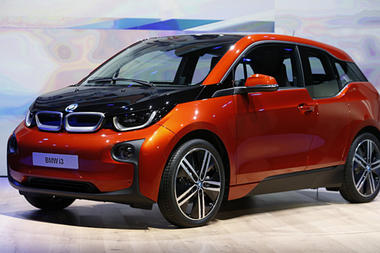BMW i3: With electric car, BMW eyes an urban future
 German automaker BMW released its first mass-production electric car Monday, with an eye towards a more urbanized future.
German automaker BMW released its first mass-production electric car Monday, with an eye towards a more urbanized future.The BMW i3 combines the electric plug-in experience with web-enabled bells and whistles and a state-of-the-art carbon-fiber design sure to help the company meet fuel-efficiency regulatory requirements in the United States and abroad.
But the new technology doesn’t come cheap, and it’s too soon to tell if the BMW i3 will cut into its luxury EV competition, much less win over a public slow to warm to plug-in technology.
“BMW is taking a very holistic approach to the electric vehicle and the idea of future transportation,” John O’Dell, senior editor for fuel efficiency and green cars at Edmunds, said in a telephone interview. “They see the world becoming more urbanized, with greater parts of the population living in urban areas, and they see the electrified car as making sense in that increasingly urbanized world.”
With a starting price of $41,350 (before tax rebates), the BMW i3 is a mid-priced car, as far as electric vehicles (EVs) go. It’s significantly costlier than the Nissan Leaf, and a step down in price from the Tesla Model S, putting it in the same ballpark as the Chevy Volt.
The i3’s range of 80 to 100 miles is comparable to the Leaf’s, but an optional small gasoline motor roughly doubles that. The so-called “range extender” also adds about $4,000 to the price tag.
BMW has tailored its sales pitch for the i3 to the markets where EVs have traditionally fared well: cities. Eco-conscious urban dwellers in New York, Los Angeles, and Chicago have been much quicker to adopt the EV as a sustainable, cost-effective means for daily city travel, than the rest of the population.
“The i3 is more than just a car,” Norbert Reithofer, chairman of the board of management of BMW said in a release at the world premiere in New York Monday. “It’s a revolutionary step towards sustainable mobility. It is purpose-built around an electric power train to serve the needs of our megacity customers.”
Perhaps even more notable for the automotive industry is BMW’s use of carbon reinforced plastic. The i3 is the first mass-market car to have a passenger frame constructed solely of the sturdy, ultralight material, giving it a feathery curb weight of 2,700 pounds. That translates to significant fuel savings and could pave the way for other automakers to follow suit.
The introduction of the i3 means another contender in what is currently a three-car race for electric car dominance. Tesla Motors has had a strong run recently, nabbing a handful of major accolades and paying back a half-billion-dollar federal loan years ahead of schedule. Nissan has enjoyed a surge in sales after slashing the price of its Nissan Leaf in January.
But there have also been high-profile failures, and electric vehicles still only make up 3.8 percent of the total automotive market, according to the Electric Drive Transportation Association.
“It’s way too early to tell who the winners and losers are,” Mr. O’Dell said. “This is a snail and a tortoise race, not even a tortoise and a hare race.”
The i3 is scheduled to go on sale in the first half of 2014.
You can return to the main Market News page, or press the Back button on your browser.

